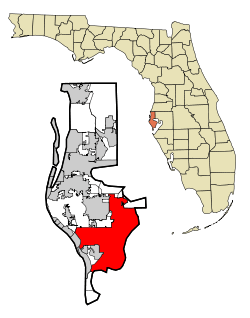St. Petersburg Police Department
The St Petersburg Police Department (SPPD) provides crime prevention and public safety services for the city of St Petersburg, Florida. The department was created in 1903. The St. Petersburg Police Department has an authorized strength of 550 sworn officers and 212 civilian support staff. The department serves the fifth largest city in the state of Florida, with a population of 250,000. The St. Petersburg Police Department is one of over 1,000 law enforcement agencies in the United States accredited by the Commission on Accreditation of Law Enforcement Agencies (CALEA).[1] Anthony Holloway is the chief of police.
| St. Petersburg Police Department | |
|---|---|
 | |
| Common name | St. Petersburg P.D. |
| Abbreviation | SPPD |
| Agency overview | |
| Formed | 1903 |
| Employees | 757 |
| Volunteers | 62 |
| Annual budget | $86.9 million (2010 FY) |
| Jurisdictional structure | |
| Operations jurisdiction | Pinellas County, Florida, United States |
 | |
| Map of St. Petersburg Police Department's Jurisdiction. | |
| Size | 64 sq mi (170 km2) |
| Population | 262,000 citizens |
| Legal jurisdiction | St. Petersburg, Florida, U.S. |
| General nature | |
| Operational structure | |
| Headquarters | 1301 First Avenue North St. Petersburg, Florida, U.S. |
| Police Officers | 562 |
| Unsworn members | 212 |
| Agency executives |
|
| Bureaus | 4
|
| Divisions | 17
|
| Facilities | |
| Districts | 1 |
| Patrol Boats | 2 |
| Website | |
| St.Petersburg Police Department | |
The department has specialized units, both uniformed and undercover, to target specific public safety issues within the city (i.e., auto thefts, violent crime).[2] The department uses community outreach programs like Park Walk and Talk,[3] Facebook, Twitter, and a tip 411[4] app to gather information from the community and address specific concerns.
Districts
The St. Petersburg Police Department has divided the city into three districts:
- District One – Bethel Heights, Campbell Park, Bayfront Hospital, Roser Park, Lassing Park, Harbordale, Coquina Key, Albert Whitted Airport, Eckerd College, Lakewood Estates, Jordan Park, Maximo, Skyway Bridge
- District Two – Downtown, Tropicana Field, The Peir, Northshore Park, The Vinoy, Harris Park, Placido Bayou, Meadowlawn, Fossil Park, Snell Isle, Shore Acres, Old Northeast, St Anthony's Hospital
- District Three – Childs Park, Tyrone Square Mall, Azalea, United Central, Garden Manor, Holiday Park, St Pete General Hospital, Yacht Club Estates
History
In 1960s African American police officers were discriminated against. They were not allowed to work in certain locations, move up in rank, and also were not permitted to arrest whites. They had separate water fountains and lockers in the police station and were referred to as "half-police officers" by the community.[5] The officers even had to deal with the their inability to arrest white people by having to wait for a white officer to come and make any actual arrests.
In 1965, a dozen officers, dubbed "the Courageous 12", sued the city for discrimination. These officers included Leon Jackson, Adam Baker, Freddie Crawford, Raymond DeLoach, Charles Holland, Robert Keys, Primus Killen, James King, Johnnie B. Lewis, Horace Nero, Jerry Styles, and Nathaniel Wooten. After losing their case, a federal appeals court, ruled in their favor in 1968, effectively ending the department's policy of segregation.[5] James B. Sanderlin was an activist and a lawyer that fought to end social and legal inequality in St. Petersburg. He was the lawyer who represented the " Courageous 12", and later went on to become the first African American judge of Pinellas County.[6]
In 2011 three SPPD officers were killed within the span of less than one month.[7][8][9]
In 2019 the courageous 12 were honored by the creation of a plaque that was placed in the Saint Petersburg FL. Police department.[10] Today there is only one living officer from the original courageous 12 group, Leon Jackson.
Controversies
Riots occurred in St. Petersburg, Florida in 1996 following the shooting and death of an African American male teenage motorist during a police traffic stop.[11]
See also
- List of law enforcement agencies in Florida
- List of U.S. state and local law enforcement agencies
References
- www.stpete.org/police. "Welcome to the St. Petersburg Police Department". police.stpete.org. Retrieved February 13, 2016.
- "64 Arrested in Multi-County Auto Theft Crackdown | Patch". St. Pete, FL Patch. Retrieved February 13, 2016.
- "St. Petersburg police Chief Tony Holloway, after 100 days in office, gets high praise". Tampa Bay Times. Retrieved February 13, 2016.
- "Tip411". police.stpete.org. Retrieved February 13, 2016.
- "St. Petersburg's 'Courageous 12' officers see familiar struggle 50 years later". Tampa Bay Times. Retrieved June 11, 2020.
- http://theweeklychallenger.com/james-b-sanderlin-black-history-award-honors-william-darling-and-elder-jordan-sr/
- "Sergeant Thomas John Baitinger". The Officer Down Memorial Page (ODMP). Retrieved February 13, 2016.
- "Police Officer Jeffrey Adam Yaslowitz". The Officer Down Memorial Page (ODMP). Retrieved February 13, 2016.
- "Police Officer David Scott Crawford". The Officer Down Memorial Page (ODMP). Retrieved February 13, 2016.
- "City honors the Courageous 12 with plaque at new police building". November 1, 2019. Retrieved April 10, 2020.
- "Neighborhoodtimes: '96 riots: After national shame, did city change?". www.sptimes.com. Retrieved February 13, 2016.